Once upon a time, there was vanilla…
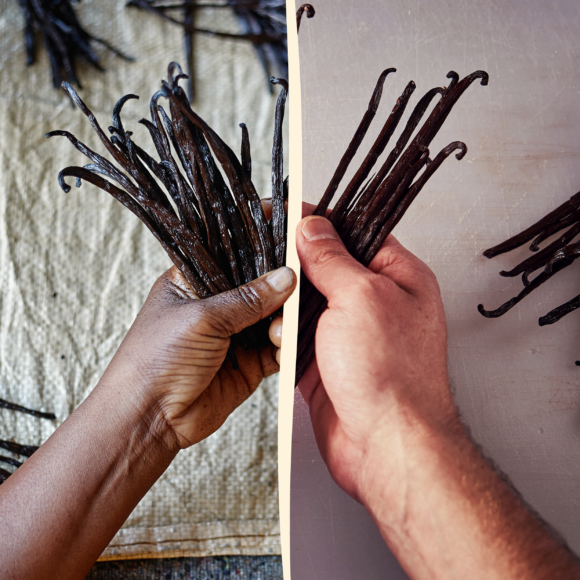
An exceptional story for an exceptional product
Let us tell you about how vanilla seeds came to be a part of our desserts, the place they have in the world but also the botanical and aromatic complexity that they offer. After you come on this delicious adventure, you will know everything there is to know about vanilla beans, the different varieties, and how they’re grown and stored.
- In the beginning…
- A very special orchid
- Inside the vanilla bean
- Vanilla production throughout the world
- The different qualities of vanilla
- Recognizing a good quality bean
- The processing stages
- Storing vanilla beans properly
In the beginning…
Vanilla is a wild orchid, native to Mexico. Its beans have been used for more than 2,000 years by the Mayans and Aztecs to flavor and sweeten their cacao beverages.
Then, in the 16th century, the Spanish conquistadors discovered this drink of the gods and the elite, and brought it back to Europe. From that moment on, the Europeans tried many times to introduce vanilla vines back home, but for a long time, their attempts were met with failure. The plants would take and blossom, but nobody managed to produce any of those famous vanilla beans.
They didn’t have Mexico’s Melipona Bees, the only insect capable of pollinating this orchid.
The Legend of Edmond
In 1841, 22 years after the vanilla orchid was introduced to Bourbon Island (now known as Reunion Island), young slave Edmond Albius discovered a technique to pollinate the flower by hand. He managed to identify which was the flower’s male organ and pollinate it using a small splinter of wood. A few days later, the flower transformed into a vanilla bean…
The introduction of vanilla throughout the world
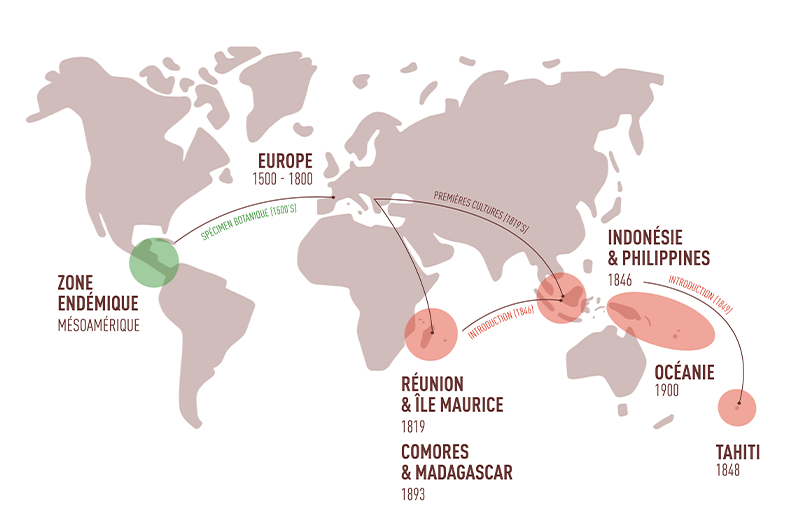
A very special orchid
Vanilla is a member of the orchid family and a hemiepiphyte, that is, it grows on other plants for physical support.
Vanilla plants can grow 15 to 20 meters long and 1 to 2 cm in diameter, climbing tree trunks using tendril-like roots at the base of each leaf. These roots are thick and green, measuring 12 to 25 cm long and 5 to 8 cm wide.
As for the aromatic flowers, they are fragile and delicate. They take the shape of rather large, light yellow trumpets that are gathered on floral buds. Their petals and sepals only bloom for one morning in a season!
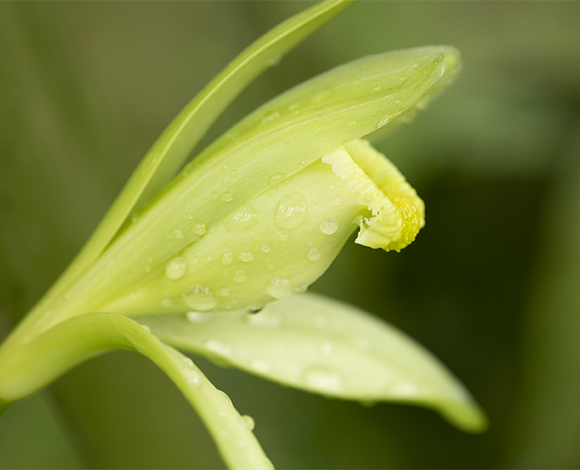
On one flower bud, there can be up to 15 flowers at different stages of maturity.
This means that the grower needs to be there at the right time to pollinate the plant and produce a fruit.
However, they cannot pollinate all the flowers, otherwise they risk exhausting the plant and producing beans that are too small!
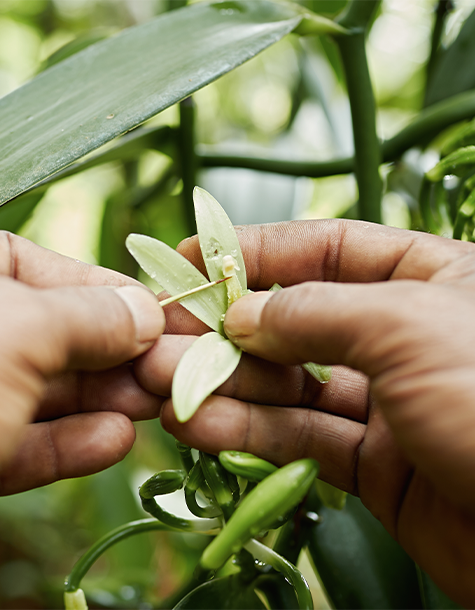
Finally, we arrive at the vanilla bean, the plant’s fruit, which measures 10 to 27 cm long and 8 to 15 mm in diameter.
It reaches maximum size after 2 months, but it will only ripen after 8 to 9 months.
Their oily pulp contains a significant number of dark black seeds and provides the vanilla’s scent.

Here are the 3 main varieties of vanilla grown in the world:
-
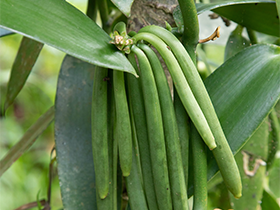
Vanilla Planifolia, or “Bourbon vanilla”, is mainly grown in the Indian Ocean. Its natural vanillin content and spiced, woody taste have made it the leading variety.
-
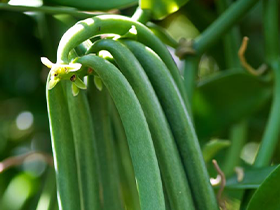
Vanilla x Tahitensis is grown in Tahiti, French Polynesia, and in New Guinea. It has a particularly floral, aniseed-tinted flavor.
-

Vanilla Pompona originates from Central America. Its very long (up to 27 cm) and plump beans have given it the nickname of “banana vanilla”. It has sweet, floral and fruity notes. Production remains rather low and it is mostly used for perfume-making.
Inside the vanilla bean

To better understand vanilla, especially what makes its seeds and aromas so special and sought after, first we need to peel it.
The vanilla bean is made up of different parts:
- The outer mesocarp, that is, the brown layer that covers the fruit entirely.
- The inner mesocarp, which holds the seeds and allows the vanillin inside to synthesize. Vanillin is a natural aromatic chemical compound that develops in the bean. It is not the only aromatic component – hundreds of others are produced throughout the bean preparation stages, giving vanilla all its aromatic complexity.
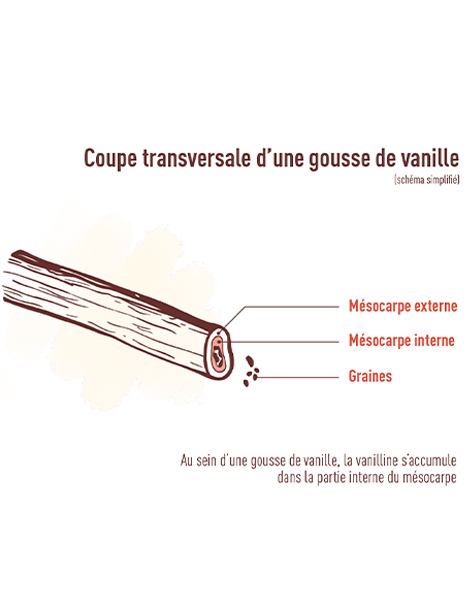
Vanilla production throughout the world
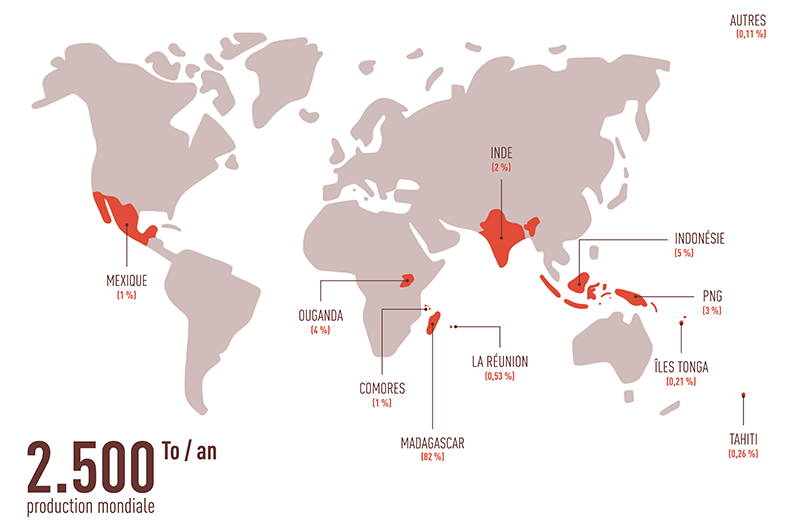
DID YOU KNOW? The “Bourbon vanilla” label was created in 1964 to identify vanilla produced from vanilla planifolia plants in the Indian Ocean (Reunion Island, Madagascar, Mauritius and Comoros), as opposed to vanilla produced in other countries.
The different qualities of vanilla
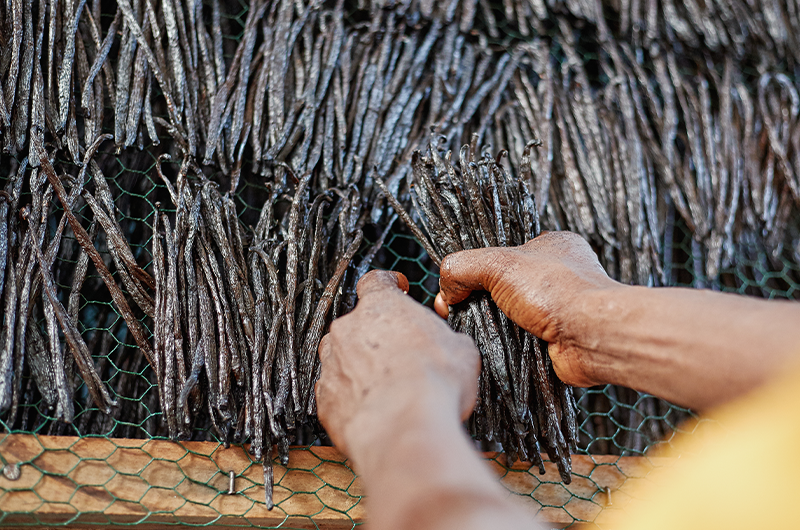
Vanilla Planifolia
Red vanilla : extraction quality
Appearance: reddish color with some stripes
Moisture content: from 20 to 27%
For manufacturing of derivatives (such as vanilla extract)
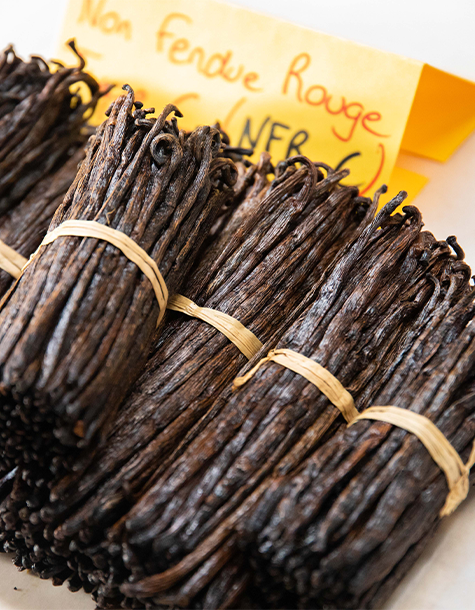
Black vanilla – gourmet quality
Appearance: black color, soft and fleshy
Moisture content: 30 to 38%
For beans usage
Because it manages every stage in the vanilla supply chain, norohy is able to select the finest “BLACK NON-SPLIT” gourmet vanilla.

Back in the day, each grower had their own stamp to mark their beans and avoid theft.
Nowadays, this practice still exists to keep the tradition alive, even if it’s not widespread.
Marking beans
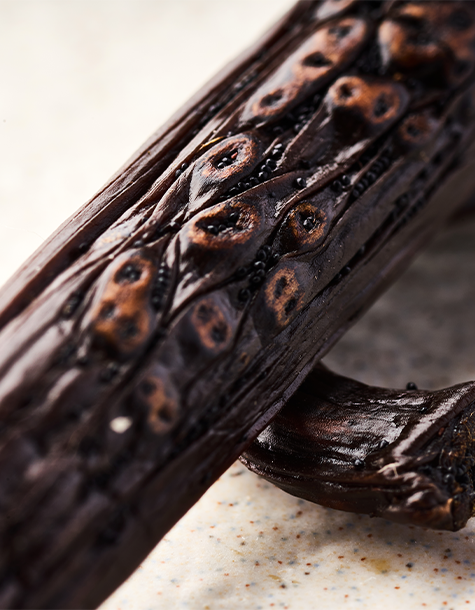
Vanilla planifolia produces a dehiscent fruit (just like grapes), which means that the beans naturally split while still on the vine when they are fully ripe.
This is also known as “late harvest” vanilla. The bean splits by a few centimeters at the bottom depending on how ripe it is.
During processing, the beans lose some of their seeds but remain very high in vanillin.
However, beans like this are relatively rare on the gourmet vanilla market, and non-split beans are the most common nowadays.
Split vanilla
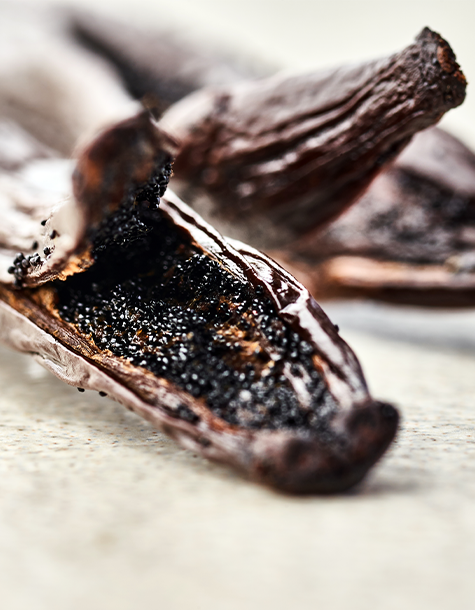
Another special feature of Vanilla planifolia: frosted vanilla
Frosted black vanilla beans are a very rare, exceptional product.
They can be recognized by the white efflorescence on the lower part of the bean, a true sign of quality.
This crystallization is connected to high vanillin content inside the bean.
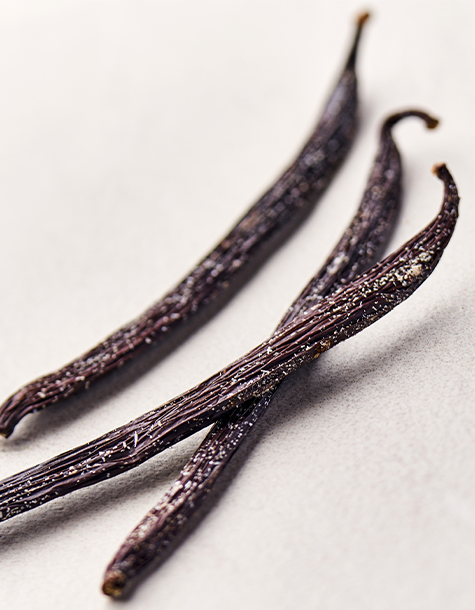
Vanilla x Tahitensis
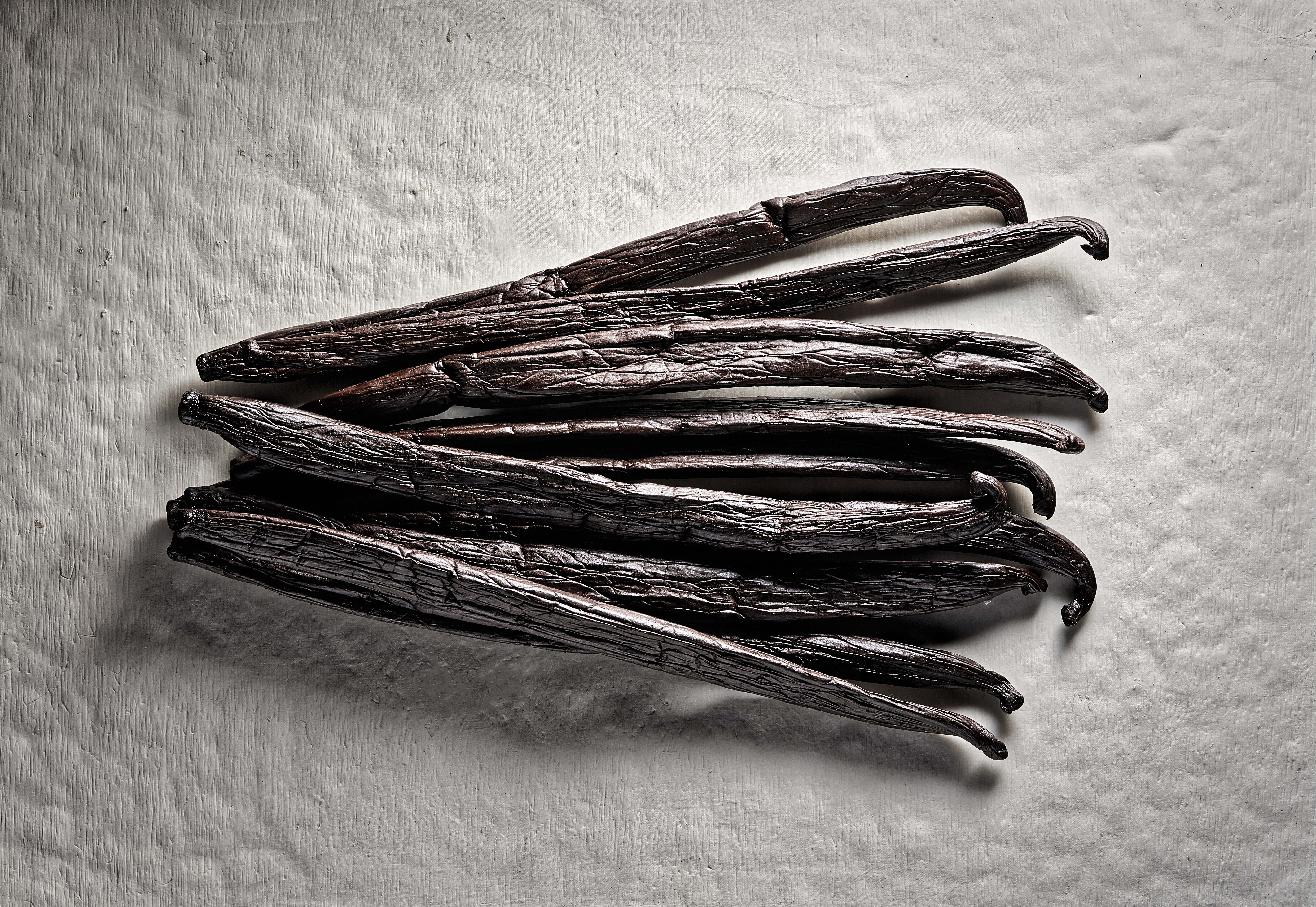
The story of what some call French Polynesia’s black gold begins in 1848. The Vanilla x tahitensis orchid was first found in a Tahitian private garden before being produced on a larger scale across the island. Today, this variety is highly valued by pastry chefs, however it is very rare, making up less than 10% of the worldwide vanilla production (mostly in French Polynesia and Papua New Guinea). Each flower is pollinated by hand and the pods are picked nine to ten months later as they reach their ripest.
When the beans turn brown, they are alternately sun-dried and shade-dried over a period of several weeks, during which time they gradually become supple and shiny. Finally, they go through a refining process to prepare them for use and help preserve them.
Unlike Vanilla planifolia and Vanilla pompona, Vanilla x tahitensis has a thinner stem and leaves. What makes Tahiti vanilla unusual is that the fruit does not open spontaneously when ripe (as it is what is known as an “indehiscent” plant). Among the vanilla found in Tahiti, there are no fewer than 14 cultivars of Vanilla x tahitensis, but only 2 are grown in large quantities – the “Tahiti” and the “Haapape”. The second has sturdier vines, while the flowers of the first are easier to fertilize.
Tahitian vanilla is bursting with an aromatic bouquet made up of over 200 molecules. Its oily, aroma-rich beans offer intense aniseed and floral notes with a hint of almond, tonka bean and balsamic vinegar.
You can see the difference between the Vanilla x tahitensis (on the left) and Vanilla planifolia – the beans of the first are thicker, brownish in color and moister.

Recognizing a good quality bean
If you want to make sure that you’re looking at the best quality product, all you need to do is trust your senses.
- Your sense of smell, to recognize the perfumed scent of vanilla and the different aromatic profiles depending on the variety.
- Your sense of sight, to choose a bean that is shiny but not too moist. The color should be uniform and it should not have any spots, scars or tears (with the exception of traditional stamps). Red/brown filaments indicate that the vanilla is of lower quality.
- Your sense of touch, to test the bean’s suppleness. You can feel the pulp by rolling it between your fingers, and when you knot the bean, it shouldn’t break.
- Your sense of taste, by using a few seeds in a recipe. Quality vanilla has high aromatic power and is capable of infusing your dish with its delicate perfume.

The risk of mold for vanilla beans
Vanillin acts as a natural anti-mold agent, protecting the bean. Vanilla that is harvested when ripe and prepared correctly will reach the right balance between vanillin content and moisture, and is at no risk of growing mold.
The processing stages
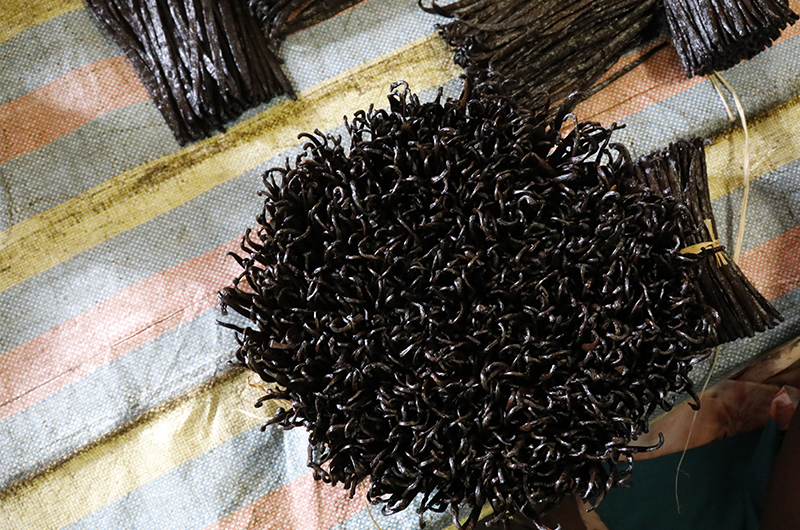
Vanilla planifolia
DID YOU KNOW? It takes 6 to 7 kg of green vanilla to make 1 kg of black vanilla.
Growing Madagascar vanilla requires very specific expertise.
To cause the plant to flower, the grower places “stress” on the plant, i.e. they cut back the shade above the vanilla plants (=light-based stress) when the dry season is in full swing (=hydration-based stress). When faced with these sources of stress, the plant will try to “defend” itself and will produce a large number of flowers 3 months later.
Key stages
-

1/ Blossoming & manual pollination:
• Period: September to December
• Duration: starting from 2 or 3 years after planting, every year -

2/ Harvesting:
• Period: June through September.
• Duration: 8 to 9 months after blossoming -
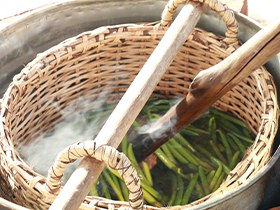
3/ Blanching:
• Using: Water at 160°F (70°C).
• Duration: 2 to 3 minutes depending on beans’ maturity
• Objective: To stop the beans from ripening -

4/ Drying & sweating:
• In crates covered with a snug lid or a jute cloth and polyethylene band
• Duration: approx. 48 hours
• Objective: To develop the vanillin and aromatic compounds (natural enzyme reaction).
-
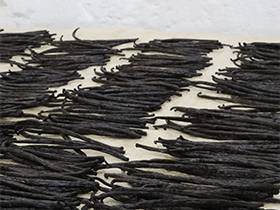
5/ Drying:
• First in the sun, then in the shade
• Duration: 1 to 2 months -
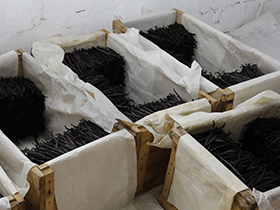
6/ Refining:
• In wooden boxes covered with wax paper
• Duration: 4 to 5 months.
• Objective: To develop secondary aromas -
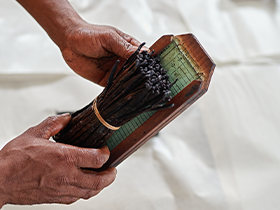
7/ Categorization:
• Sorting the beans by color
• Measuring/gauging: Gauging the batches using a ruler
-
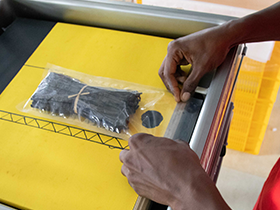
8/ Packaging and shipping
Vanilla x Tahitensis

-
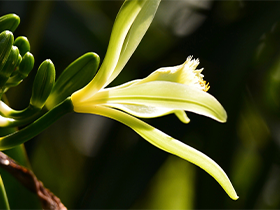
Blossoming occurs during the Southern Hemisphere’s winter: June to October. Over this period, the cool nights cause the plants to flower.
-
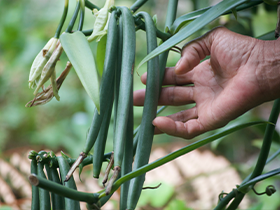
The beans reach adult size 2 to 3 months after pollination. The harvest takes place after 9 to 10 months.
-
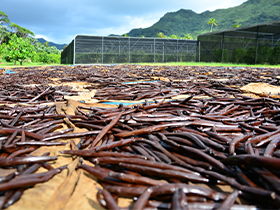
Unlike Vanilla planifolia, Vanilla x tahitensis produces indehiscent fruit, so the drying & sweating and blanching steps are not necessary, because there is no need to stop the beans from ripening.
-
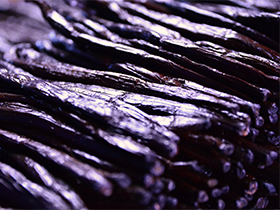
It takes four months after the beans are harvested to complete the preparation process. Refining is a very important step to develop the secondary aromas.
Storing vanilla beans properly
To keep vanilla in optimal conditions, you need to follow a few instructions.
First of all, it’s important to know that vanilla does not like heat, moisture, light, or air.
- Glass tubes or jars that are not too big are a good option. As they are fully airtight, the beans keep well inside. It’s best to use a container that fits the vanilla snugly and therefore limits the amount of air inside. Rather than cork, an aluminum or plastic cap is better to avoid the risk of mold.
- A metal box that is similar in size to the beans is also a viable option that limits contact with the air.
- Or, vanilla beans can be kept in sous vide packaging, which preserves all their aromatic qualities!
Over time, vanilla will generally lose moisture as it evolves. If you follow the above advice, you will be sure to be able to keep your vanilla beans at their aromatic best for 12 to 18 months, so that your vanilla is still soft when you come to use it.
Also, it is not advised to keep vanilla beans wrapped in aluminum, paper towels, plastic wrap or a plastic bag. These will all dry out the bean and could lead to mold growing.
You should also avoid storing vanilla with other spices, otherwise you risk mixing and changing the aromas.
